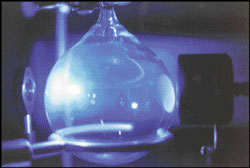Brent D. Johnson, Senior News Editor
Researchers at the Laboratorio de Química de Plasmas y Estudios Planetarios at the Universidad Nacional Autónoma de México are using laser-simulated lightning strikes to help them understand what happened to the Earth's atmosphere 4.5 billion to 2.2 billion years ago during the Hadean period.

An Nd:YAG laser creates simulated lightning strikes for studies of nitrogen oxides.
Rafael Navarro-González and his team have shown how a decrease in the production of nitric oxide that occurred during a 1 million-year interval within that period in the history of the Earth was a result of lightning discharge.
Lightning produces significant nitrogen oxides. In the early years, these key elements percolated down into the soil and were transported to the ocean, where they became the components of life.
However, as the atmospheric concentration of CO2 dropped, light-ning's properties changed. Carbon dioxide slowly dissolved into the oceans, but the molecular nitrogen did not oxidize.
Unable to obtain nitrogen from either the soil or the ocean, emerging bacterial populations depended on atmospheric and oceanic chemistry for survival. Bacteria that use atmospheric nitrogen appear to give evidence that there was a serious nitrogen deficit during this period.
Making sparks
To study this ecological assertion, Navarro-González and his team have been using Continuum Nd:YAG lasers to simulate the effects of lightning strikes in a realistic geophysical model of ancient Earth.
The first laser, a Surelite II-10 pulsed Nd:YAG at the 1064-nm fundamental wavelength, creates the plasma. A second laser, Surelite I-10, used at 532 and 355 nm in a Mach-Zehnder interferometer, analyzes the evolution of the plasma, which lasts about 1 ms.
The Nd:YAG has several advantages over previous "arcs and sparks" experiments, Navarro-González said.
During traditional lightning-study methods, the high temperatures melted the electrodes, causing catalytic effects that created contamination. The heated gas in these experiments also produced oxides of nitrogen and small, potentially explosive, gas leaks.
Finally, researchers were unable to measure the energy yield in an arc/spark system.
The laser, by comparison, has no electrodes, works well on a microscale and presents no risk of explosion from flammable gases. In addition, the diagnostics allow researchers to characterize the expansion of gases and the evolution of the plasma.
The big debate, said Navarro-González, has been whether propagation occurs on the shock wave or on the lightning core flash itself. The researchers recently discovered that most oxides form at the lightning core. To more accurately mimic nature, they would like to extend the lifetime of the lightning flash by using multiple lasers.